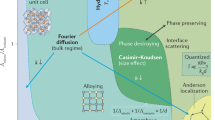Abstract
The lattice thermal conductivity arises from contributions by phonons of all frequencies. The mean free path l(ω) is limited mainly by three-phonon interactions, and l i(ω)∝ω−2 T −1 where ω is the phonon frequency, and T is the absolute temperature. Since the spectral specific heat varies as ω 2, the spectral thermal conductivity is independent of frequency, and low frequencies play a larger role than they do in the heat content. The effect of additional scattering processes due to defects must be compared to intrinsic scattering, not just at the highest frequency, but over the full spectral range. This enhances the resistance due to grain boundaries and large obstacles, and reduces the effect of point defects. Some typical examples are discussed. The role of low-frequency phonons may be even further enhanced if longitudinal low-frequency phonons have their interaction with other phonons reduced by wave vector conservation. Such modes would then contribute substantially to the overall thermal conductivity, and this contribution would be sensitive to grain size and to large-scale defects. However, the mean free path must be consistent with ultrasonic attenuation data. This enhanced sensitivity may be observable.
Similar content being viewed by others
References
P. G. Klemens, Thermal Conductivity, Vol. I (Academic Press, London, 1969), pp. 1–68.
G. Leibfried and E. Schlömann, Nachr Akad. Wiss. Göttingen 2a:71 (1954).
G. A. Slack, Solid State Physics, Vol. 34 (Academic Press, New York 1979), pp. 1–71.
D. L. Mooney and R. G. Steg, High Temp-High Press. 1:237 (1969).
D. J. Ecsedy and P. G. Klemens, Phys. Rev. B15:5957 (1977).
P. G. Klemens, G. F. Hurley, and F. W. Clinard, Second Topical Meeting on the Technology of Controlled Nuclear Fusion, Richland WA, Vol. 3 (USERDA CONF 760935, Washington DC, 1976), pp. 957–964.
F. W. Clinard, J. M. Bunch, and W. A. Ranken, Proc. Int. Conf. on Radiation Effects and Tritium Technology for Fusion Reactors, Gatlinburg TN, Vol. 2 (USERDA CONF 750989, Washington DC, 1975), p. 498.
C. A. Ratsifaritana, doctoral dissertation, University of Connecticut, Storrs, Conn., 1979.
I. Pomeranchuk, J. Phys. (U.S.S.R.) 4:259 (1941).
P. G. Klemens, Physical Acoustics, Vol. 3b, (Academic Press, New York, 1965), pp. 201–234.
A. Akhieser, J. Phys. (U.S.S.R.) 1:277 (1939).
Author information
Authors and Affiliations
Rights and permissions
About this article
Cite this article
Klemens, P.G. Theory of lattice thermal conductivity: Role of low-frequency phonons. Int J Thermophys 2, 55–62 (1981). https://doi.org/10.1007/BF00503574
Received:
Issue Date:
DOI: https://doi.org/10.1007/BF00503574




